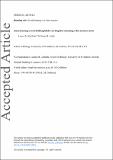Social learning in nest-building birds watching live-streaming video demonstrators
Abstract
Determining the role that social learning plays in construction behaviors, such as nest building or tool manufacture, could be improved if more experimental control could be gained over the exact public information that is provided by the demonstrator, to the observing individual. Using video playback allows the experimenter to choose what information is provided but will only be useful in determining the role of social learning if observers attend to, and learn from, videos in a manner that is similar to live demonstration. The goal of the current experiment was to test whether live‐streamed video presentations of nest building by zebra finches Taeniopygia guttata would lead observers to copy the material choice demonstrated to them. Here, males that had not previously built a nest were given an initial preference test between materials of 2 colors. Those observers then watched live‐stream footage of a familiar demonstrator building a nest with material of the color that the observer did not prefer. After this experience, observers were given the chance to build a nest with materials of the 2 colors. Although two‐thirds of the observer males preferred material of the demonstrated color after viewing the demonstrator build a nest with material of that color more than they had previously, their preference for the demonstrated material was not as strong as that of observers that had viewed live demonstrator builders in a previous experiment. Our results suggest researchers should proceed with caution before using video demonstration in tests of social learning.
Citation
Guillette , L M & Healy , S D 2019 , ' Social learning in nest-building birds watching live-streaming video demonstrators ' , Integrative Zoology , vol. 14 , no. 2 , pp. 204-213 . https://doi.org/10.1111/1749-4877.12316
Publication
Integrative Zoology
Status
Peer reviewed
ISSN
1749-4869Type
Journal article
Collections
Items in the St Andrews Research Repository are protected by copyright, with all rights reserved, unless otherwise indicated.

